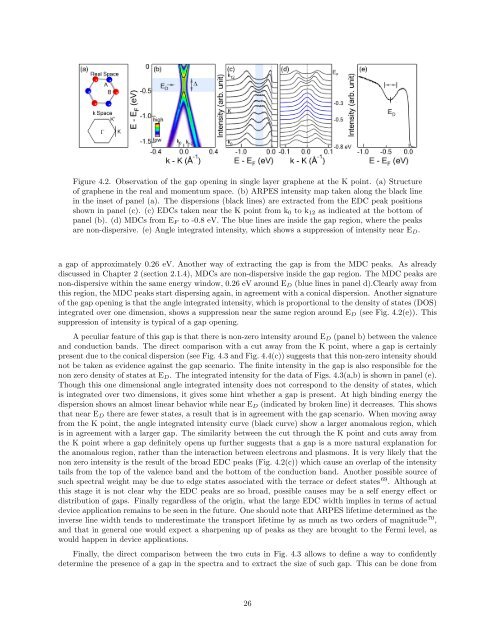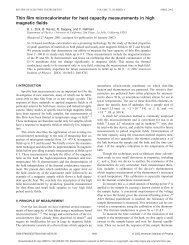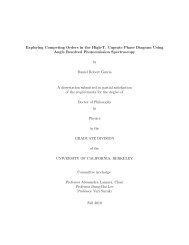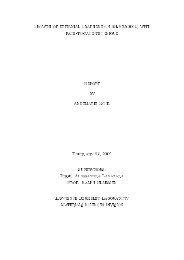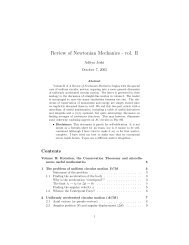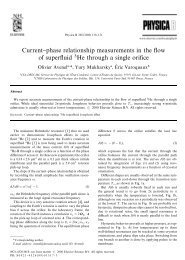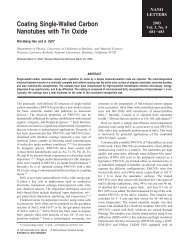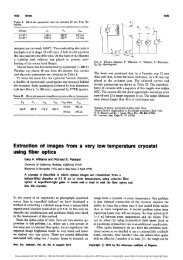Dirac Fermions in Graphene and Graphiteâa view from angle ...
Dirac Fermions in Graphene and Graphiteâa view from angle ...
Dirac Fermions in Graphene and Graphiteâa view from angle ...
You also want an ePaper? Increase the reach of your titles
YUMPU automatically turns print PDFs into web optimized ePapers that Google loves.
Figure 4.2. Observation of the gap open<strong>in</strong>g <strong>in</strong> s<strong>in</strong>gle layer graphene at the K po<strong>in</strong>t. (a) Structure<br />
of graphene <strong>in</strong> the real <strong>and</strong> momentum space. (b) ARPES <strong>in</strong>tensity map taken along the black l<strong>in</strong>e<br />
<strong>in</strong> the <strong>in</strong>set of panel (a). The dispersions (black l<strong>in</strong>es) are extracted <strong>from</strong> the EDC peak positions<br />
shown <strong>in</strong> panel (c). (c) EDCs taken near the K po<strong>in</strong>t <strong>from</strong> k 0 to k 12 as <strong>in</strong>dicated at the bottom of<br />
panel (b). (d) MDCs <strong>from</strong> E F to -0.8 eV. The blue l<strong>in</strong>es are <strong>in</strong>side the gap region, where the peaks<br />
are non-dispersive. (e) Angle <strong>in</strong>tegrated <strong>in</strong>tensity, which shows a suppression of <strong>in</strong>tensity near E D .<br />
a gap of approximately 0.26 eV. Another way of extract<strong>in</strong>g the gap is <strong>from</strong> the MDC peaks. As already<br />
discussed <strong>in</strong> Chapter 2 (section 2.1.4), MDCs are non-dispersive <strong>in</strong>side the gap region. The MDC peaks are<br />
non-dispersive with<strong>in</strong> the same energy w<strong>in</strong>dow, 0.26 eV around E D (blue l<strong>in</strong>es <strong>in</strong> panel d).Clearly away <strong>from</strong><br />
this region, the MDC peaks start dispers<strong>in</strong>g aga<strong>in</strong>, <strong>in</strong> agreement with a conical dispersion. Another signature<br />
of the gap open<strong>in</strong>g is that the <strong>angle</strong> <strong>in</strong>tegrated <strong>in</strong>tensity, which is proportional to the density of states (DOS)<br />
<strong>in</strong>tegrated over one dimension, shows a suppression near the same region around E D (see Fig. 4.2(e)). This<br />
suppression of <strong>in</strong>tensity is typical of a gap open<strong>in</strong>g.<br />
A peculiar feature of this gap is that there is non-zero <strong>in</strong>tensity around E D (panel b) between the valence<br />
<strong>and</strong> conduction b<strong>and</strong>s. The direct comparison with a cut away <strong>from</strong> the K po<strong>in</strong>t, where a gap is certa<strong>in</strong>ly<br />
present due to the conical dispersion (see Fig. 4.3 <strong>and</strong> Fig. 4.4(c)) suggests that this non-zero <strong>in</strong>tensity should<br />
not be taken as evidence aga<strong>in</strong>st the gap scenario. The f<strong>in</strong>ite <strong>in</strong>tensity <strong>in</strong> the gap is also responsible for the<br />
non zero density of states at E D . The <strong>in</strong>tegrated <strong>in</strong>tensity for the data of Figs. 4.3(a,b) is shown <strong>in</strong> panel (e).<br />
Though this one dimensional <strong>angle</strong> <strong>in</strong>tegrated <strong>in</strong>tensity does not correspond to the density of states, which<br />
is <strong>in</strong>tegrated over two dimensions, it gives some h<strong>in</strong>t whether a gap is present. At high b<strong>in</strong>d<strong>in</strong>g energy the<br />
dispersion shows an almost l<strong>in</strong>ear behavior while near E D (<strong>in</strong>dicated by broken l<strong>in</strong>e) it decreases. This shows<br />
that near E D there are fewer states, a result that is <strong>in</strong> agreement with the gap scenario. When mov<strong>in</strong>g away<br />
<strong>from</strong> the K po<strong>in</strong>t, the <strong>angle</strong> <strong>in</strong>tegrated <strong>in</strong>tensity curve (black curve) show a larger anomalous region, which<br />
is <strong>in</strong> agreement with a larger gap. The similarity between the cut through the K po<strong>in</strong>t <strong>and</strong> cuts away <strong>from</strong><br />
the K po<strong>in</strong>t where a gap def<strong>in</strong>itely opens up further suggests that a gap is a more natural explanation for<br />
the anomalous region, rather than the <strong>in</strong>teraction between electrons <strong>and</strong> plasmons. It is very likely that the<br />
non zero <strong>in</strong>tensity is the result of the broad EDC peaks (Fig. 4.2(c)) which cause an overlap of the <strong>in</strong>tensity<br />
tails <strong>from</strong> the top of the valence b<strong>and</strong> <strong>and</strong> the bottom of the conduction b<strong>and</strong>. Another possible source of<br />
such spectral weight may be due to edge states associated with the terrace or defect states 69 . Although at<br />
this stage it is not clear why the EDC peaks are so broad, possible causes may be a self energy effect or<br />
distribution of gaps. F<strong>in</strong>ally regardless of the orig<strong>in</strong>, what the large EDC width implies <strong>in</strong> terms of actual<br />
device application rema<strong>in</strong>s to be seen <strong>in</strong> the future. One should note that ARPES lifetime determ<strong>in</strong>ed as the<br />
<strong>in</strong>verse l<strong>in</strong>e width tends to underestimate the transport lifetime by as much as two orders of magnitude 70 ,<br />
<strong>and</strong> that <strong>in</strong> general one would expect a sharpen<strong>in</strong>g up of peaks as they are brought to the Fermi level, as<br />
would happen <strong>in</strong> device applications.<br />
F<strong>in</strong>ally, the direct comparison between the two cuts <strong>in</strong> Fig. 4.3 allows to def<strong>in</strong>e a way to confidently<br />
determ<strong>in</strong>e the presence of a gap <strong>in</strong> the spectra <strong>and</strong> to extract the size of such gap. This can be done <strong>from</strong><br />
26


